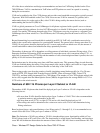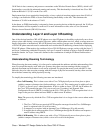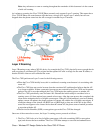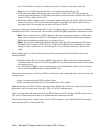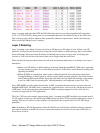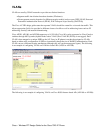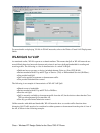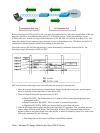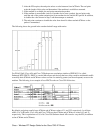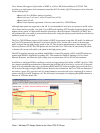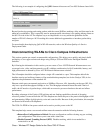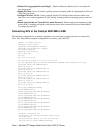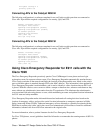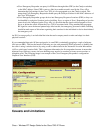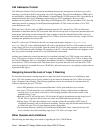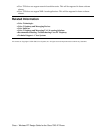
Cisco Aironet APs support a QoS similar to EDCF as of Cisco IOS Software Release 12.0T SW. This
provides up to eight queues for downstream (toward the 802.11b clients) QoS. These queues can be allocated
in the following ways:
Based on ToS or DiffServ settings of packets.•
Based on Layer 2 or Layer 3 Access Control Lists (ACLs).•
Based on the VLAN.•
Based on the dynamic registration of devices such as the Cisco 7920 IP Phone.•
Although eight queues are supported on the AP, it is recommended to only have two queues for traffic on the
AP to ensure the best possible voice QoS. Voice (RTP) and signaling (SCCP) traffic should be placed into the
highest priority queue. All data traffic should be placed into a best effort queue. While 802.11b EDCF does
not guarantee that voice traffic is protected from data traffic, using this queuing model should provide the best
statistical results for voice QoS.
The Cisco 7920 IP Phones support a QoS similar to EDCF for upstream (toward the AP) traffic. In additional,
the Cisco 7920 dynamically announces its presence with the Cisco Aironet AP to ensure its downstream
traffic is placed into the high priority queue on the AP. This dynamic announcement is done through Cisco
Discovery Protocol (CDP). The CDP packets are sent from the Cisco 7920 to the AP and identify the phone
so that the AP can place all traffic to the phone in the high priority queue.
The SCCP signaling messages are marked with DiffServ Assured Forwarding (AF)31, and RTP packets are
marked with DiffServ Expedited Forwarding (EF). This matches the DiffServ markings of Cisco wired
Ethernet IP phones, and allows the QoS settings to be consistent from LAN to WLAN environments.
In addition to setting the DiffServ markings correctly and supporting a QoS similar to EDCF, the Cisco 7920
also supports an intelligent mechanism to determine the QoS that can be provides by a given AP. It does this
based on an algorithm that takes into consideration RSSI and RF CU based on updates received by the Cisco
AP in beacon messages using the QBSS element. Based on this information, the Cisco 7920 can determine if
the load on a given AP is excessive and if it should attempt to associate with a less congested AP in order to
preserve the QoS of an IP Telephony call. The following is an example of configuring the QBBS element in
beacons on VxWorks−based APs:
Cisco − Wireless IPT Design Guide for the Cisco 7920 IP Phone



